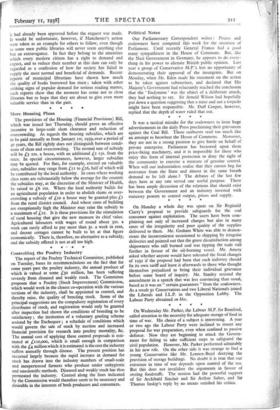More Housing Plans The provisions of the Housing (Financial Provisions)
Bill, which was issued last Thursday, should prove an effective incentive to large-scale slum clearance and reduction of overcrowding. As regards the housing subsidies, which are to be paid annually as from January 1st, 1939, over a period of 4o years, the Bill rightly does not distinguish between condi- tions of slum and overcrowding. The normal rate of subsidy will be £5 los. a house, with an additional £2 15s. from the rates. In special circumstances, however, larger subsidies may be quoted. For flats, for example, erected on valuable sites, subsidies may range from kr 1 to f26, half of which will be contributed by the local authority. In cases where working class rents are substantially below the average for the country the subsidies may, at the discretion of the Minister of Health, be raised to £6 los. Where the local authority builds for an agricultural population in order to abolish slums or over- crowding a subsidy of £10 a house may be granted plus kr from the rural district council. And where costs of building are exceptionally high the Minister may raise the subsidy to a maximum of £12. It is these provisions for the stimulation of rural housing that give the new measure its chief value. Agricultural labourers with wages of round about 32s. a week can rarely afford to pay more than 3s. a week in rent, and decent cottages cannot be built to let at that figure economically. There is, therefore, no alternative to a subsidy, and the subsidy offered is not at all too high.


















































 Previous page
Previous page